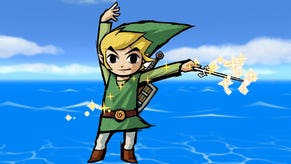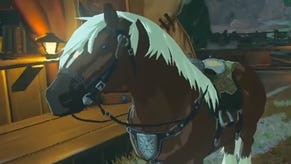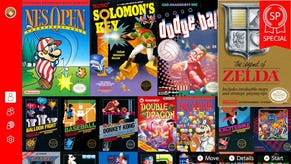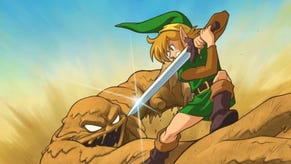The Legend of Zelda: A Link to the Past
Two Zelda games for the price of one.
There can be no doubt that Nintendo's strategy of releasing old SNES games on the GBA is very hit and miss. Super Mario Advance, for example, is simply not worth £30 to most people, whereas Yoshi's Island is a joy to play for gamers both old and new, and having it on a portable is fantastic. What we'd really like to see is more ports like The Legend of Zelda: A Link to the Past - games which make no pretence about having enhanced or expanded themselves directly, whilst introducing a handsome helping of new content in a totally new guise.
But before we get too excited about that, let's tend to the past.
One of Nintendo's best games
The Legend of Zelda took a truly pivotal step on the Super Nintendo with the game commonly known as Zelda III. There are a million and one different things to praise about the game - the sheer size of the quest; the diversity of inventory items and their applications in the game world; the dungeon design and the subtle difficulty curve; the way the game reinvents itself halfway through by throwing in a "dark side" world, with all sorts of intricate past/present puzzles to negotiate; the dow-eyed hero and the childish quest which invented a lot of RPG clichés; and the way that Shigeru Miyamoto's team were always willing to go the silly route if it was more fun. One of the first significant boss battles at the end of the East Palace dungeon, for example, is a group of six bouncing knights who turn the room into an energizer bunny convention, and the most annoying obstacles in dungeons are cannon balls and electric blobs which bounce around like Windows screensavers.
And then there's the tech. Graphically the game can hardly stand up to the likes of Golden Sun, but the cartoon-quality line work is a much worthier precursor to the Cube Zelda than the grown-up-looking N64 outings, and although the environments aren't hugely detailed, there's never any question of what's foreground and background, never any collision detection issues, never any dodgy clipping, and even the changes made in order to scale the game to GBA are largely unnoticeable. For example, there's a lot more scrolling now to make up for the lack of screen space, but as the game was never much about ranged attacks (the boomerang and bow work fine in closer quarters), and the scrolling is handled so smoothly, you barely notice it.
It ain't broke, so why�
However despite keeping 99.9 per cent of the code as it was, Nintendo and Capcom couldn't resist gratuitously toying with the odd bit here and there, and like their SNES ports in general, there are good bits and bad. The worst is probably the audio update - faced with a slightly tinnier output, the developer has inexplicably made Link yelp every time he does something� like swing his sword. Given how many times Link swings his sword during the course of this 20-hour-plus adventure, and the "Ya!" sound he makes, it's no surprise that this rapidly becomes utterly contemptible. But on the other hand, they've thrown in one of those all-important Sleep mode functions for freezing the game state and conserving power when it's inconvenient to save or switch off.
And short of changing it to a licensed Jolly Green Giant game and changing all the swords to walkie-talkies, Ninty would need to work really hard to mess this game up. It's still stunning. You might wonder what's so special these days about a map with a dozen or so big dungeons to explore and lots of villagers to talk to in the overworld, but then again Metroid's just a shoot 'em up to those who can't be arsed to play it. Link To The Past balances plot elements, dungeon trawling, puzzle solving, boss fighting, item collection and sub-quests masterfully.
It's like a gateway drug for the genre - largely thanks to a simple control scheme (which maps perfectly to the GBA - shifting map functions and item-tossing from the absent diamond buttons to the shoulders), and thanks also to a gentle learning curve, and an engrossing quest to avenge Link's father and rescue a beautiful maiden from the depths of Agahnim's castle. Even a decade on, it's still amazingly deep, with all sorts of sub-quests to complete - it's one of those games which manages to be hugely accessible without sacrificing depth, and let's you play it as thoroughly as you want.
Foursome
On its own, A Link to the Past is worth owning. Unless you plan to go back and play the SNES version instead (which will always be fundamentally superior), it's probably worth owning whether or not you've played it, rendering the "new" element from Capcom somewhat moot. However, if you plan to ignore it once the single player adventure is over, then allow us to humbly suggest you don't!
Although it was never going to be as enthralling as a single player Link outing, Four Swords is a remarkably enjoyable piece of work. The premise is dutifully idiotic, with the fairies replicating young Link four times over (one different-coloured hero for each player) in order to rescue the princess in a quest that runs parallel to the upcoming Wind Waker adventure on GameCube. The game is split up into the usual slew of dungeons in four main stages, and the design varies from obvious, one-man traditional Zelda problems to the quandaries that really do require two-to-four players to solve. All the while you're competing for the most rupees and Medals of Courage with your fellow adventurers. There are also new objects to get the hang of, like the Magnet Glove, useful for grabbing shield-toting Links and yanking them across chasms, and the design happily mixes elements of old Zeldas with more up-to-date ideas. It isn't as grid-based as A Link to the Past, either, allowing you to shrink down to a couple of pixels on occasion to get through mouse holes and other openings.
But surely if much of the game is built for four players, you can't play it properly with less than four? Not so. The game actually scales itself up or down depending on the number, and only gives you appropriate dungeons, puzzles and items. And not content with that, your efforts in A Link to the Past and Four Swords complement one another - unlocking the Beam Sword attack in the former grants you access to it in the latter, and finishing the latter unlocks even more, GBA-exclusive sub-quests in the former.
Admittedly it feels a little odd playing the finely detailed, brightly coloured Four Swords after playing such a chunky, thick-edged game as Zelda III (we mean it in a nice way), but having them both on one cart is a stroke of genius. They're both the perfect carrot for one another; depending on the gamer, one or other is likely to lure you in and introduce you to the other. The only problem is finding people to share the experience with - but if you live with a like-minded gamer then we'd strongly recommend you both buy it.
We're just grateful for another excuse to play it
The Legend of Zelda: A Link to the Past really is a contender for the best GBA cart to date. If only it wasn't 90 per cent rehashed then we would probably go that far. As it is, it's an indispensable game, combining arguably the finest RPG/adventure the 16-bit era ever produced (even compared to the likes of Secret of Mana and Final Fantasy VI) with an expertly realised multiplayer rendition of Zelda. Capcom really is getting a grip on these handheld Zeldas now, and surely with Oracle of Ages/Seasons and Four Swords under its belt, it is finally ready to produce the first, full-scale original GBA outing for our green-clothed hero. Come on Nintendo; sign the cheque.
















